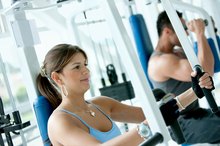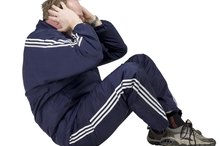Pain During Leg Raises
Leg raises are one of the most effective exercises that target your abs from the bottom. The exercise is variable enough to accommodate any fitness level, and most variations require minimal equipment. If you have pain during your leg raises, you could be using improper form or a too-difficult variation. If the pain lingers after the exercise, it may be the result of an injury.
Leg Raise Methods
The typical leg raise is done on a flat plane, either the floor or a bench. Lie on your back and straighten your legs. Keeping your legs together, raise them off the floor until they're perpendicular to your body, lower them back down and repeat. To make it harder, perform the exercise on an incline bench. To make it even harder, perform the leg raises while hanging from a pull-up bar. If the standard version is too difficult, bending your legs slightly can make it a bit easier.
- The typical leg raise is done on a flat plane, either the floor or a bench.
- To make it harder, perform the exercise on an incline bench.
Insufficient Back Support
The Best Exercises to Lose Weight in Your Hips
Learn More
If you experience pain in your lower back during leg raises, you probably aren't supporting your back properly. Try tucking your hands below your lower back for support while you do the exercise. A different approach is to begin the exercise with your legs straight up in the air, then lower them only to the point where your lower back begins to lift from the ground. This technique allows you to find the right range of motion for you to work within without aggravating your lower back.
- If you experience pain in your lower back during leg raises, you probably aren't supporting your back properly.
- A different approach is to begin the exercise with your legs straight up in the air, then lower them only to the point where your lower back begins to lift from the ground.
Too Much, Too Soon
Jumping right into a difficult exercise that your body isn't ready for can cause pain in the muscle you work, as well as all of the muscles that support the movement. In the case of leg raises, if you have pain in your abs, lower back, hip flexors, quads or obliques, back off a little. If you're using ankle weights, take them off. If you're doing the hanging version, try the incline version. If even doing the exercise on a flat plane gives you pain, try bending your knees. You should feel resistance during the move, but pain is a signal that damage is occurring and you should lighten the load.
- Jumping right into a difficult exercise that your body isn't ready for can cause pain in the muscle you work, as well as all of the muscles that support the movement.
- If you're using ankle weights, take them off.
When to See a Doctor
Reverse Crunches & Lower Back Pain
Learn More
If over-the-counter pain relievers, rest and ice don't relieve the pain, or if it worsens, seek medical attention. If the back pain comes with fever, chills or unexplained weight loss, it could be a symptom of a serious condition unrelated to exercise, so see your doctor immediately.
Related Articles
References
- American Academy of Orthopaedic Surgeons: Low Back Pain
- ShapeFit: Abs Exercises - Flat Bench Abdominal Leg Raises For Six Pack Abs
- ExRx.net: Weighted Incline Leg Raise
- Low Back Pain Risk Factors Identified. American Academy of Orthopaedic Surgeons.
- Cherkin, D.C. (2016) Mindfulness-Based Stress Reduction vs Cognitive Behavioral Therapy. JAMA, 315(12), pp. 1240–1249. doi: 10.1001/jama.2016.2323.
- Deyo, R. Overtreating Chronic Back Pain: Time to Back Off? J Am Board Fam Med. Jan-Feb 2009.
Writer Bio
Angela Brady has been writing since 1997. Currently transitioning to a research career in oncolytic virology, she has won awards for her work related to genomics, proteomics, and biotechnology. She is also an authority on sustainable design, having studied, practiced and written extensively on the subject.









